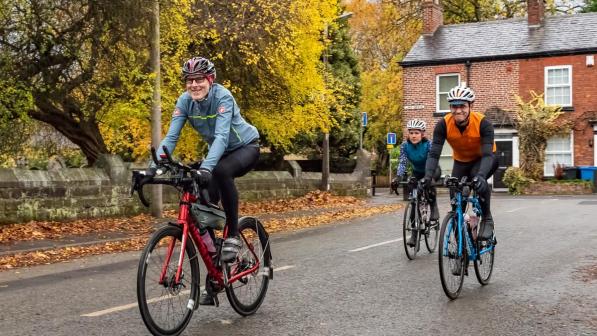Winter training tips for experienced riders

Short days and bad weather mean getting out on the bike is a challenge for many of us, even if we are experienced riders. But winter doesn't mean hibernation: there’s plenty you can do through to make the best of things until spring comes.
Of course, first of all you’ll have to get yourself sorted with the basics. From what to wear and how to get your bike winter ready, check out our beginner’s tips for being prepared for the wet and windy season.
Ride to the conditions
Even experienced riders may have to adjust their riding style. You’re likely to come across wet roads or icy conditions, especially if you go out early in the morning or you are riding on quieter roads that haven't been gritted.
Plan your routes with an average pace that suits the circumstances, be aware of the shorter hours of daylight and avoid areas you know are likely to have poor conditions where possible. Concentrate when cornering especially if you don’t know the roads, and take a wider, slower line so you avoid sliding out and coming off the bike.
Plan ahead
Winter is the perfect time to plan for next year. Use your down time to look ahead for events, set yourself some goals and work out what you want to achieve on the bike.
Goal setting is a proven way to help you achieve more, whether you want to set yourself a new challenge, achieve personal records or want to compete against others in organised competitions or races. Work out what you want to achieve then work back from that by setting yourself smaller targets that break down the main goal into more manageable challenges. From there you should then be able to work out what you need to do to achieve your target, as well as knowing that your goals are both realistically achievable and suitably ambitious.
If you do have an ambitious target you can use winter to plan out how you will train to achieve it.
Riders who set out a detailed and structured training plan are more likely to be successful. Of course you can be flexible, and only go into as much detail as you feel comfortable with, but a good plan will be structured to include a macrocycle (usually a year) which is then broken down into mesocycles (usually lasting 2-6 weeks) and then even further into microcycles (usually a week). This will help you come up with structured training that will get the best out of yourself as well ensuring you don’t over train, and can easily incorporate all of your events and goals for the year.
Make best use of your time
With the shorter days and the Christmas party season, you're likely to have plenty disrupting your riding time. Interval training is one of the best ways to get the most bang for your buck from reduced time in the saddle. There’s plenty of research that demonstrates the big impact interval training can have in even short training sessions, whatever your goals are.
Essentially, it involves mixing short ‘intervals’ of high intensity efforts with periods of low intensity (or rest) efforts. There are lots of different ways of doing interval training that vary how many ‘intervals’ you do, how long those intense periods are, and how hard they are too. You can do them outside on the bike, or for ease and accuracy or you can do them inside on a turbo trainer or exercise bike.
Just one or two short, sharp sessions a week will prove beneficial to your fitness when you can get back into longer rides with the return of summer.
Strength training
If you ride a lot, you’ll probably find that most of your cycling is skewed towards the Spring/Summer months (apart from cyclocross riders and hill climbers). The majority of events or group rides tend to be when the weather is nicer and more people are about. If you find that you have a packed schedule then, you may find winter is the best time to put in some resistance training.
Serious strength work requires time to recover; after heavy training you need to give the body a chance to adapt the stress you have put it under. This can be difficult if you are riding all the time, so winter can be a good time to take some time to build up strength and muscular endurance. Whether you use weights, bodyweight exercises, or a combination, following a strength training plan for 6-12 weeks through winter can improve your performance dramatically when you return to more intense riding in the new season.
Rest
Rest is a vital part of any training plan, so if you cycle all year round you will have to factor in an opportunity to take time off or lower the mileage you do. This will reduce both mental and physical fatigue that will build up over time, as well as being helpful to rediscover your motivation to cycle should it have dropped.
Winter is logically the best time to take a few weeks off for most people, with less hours of daylight and worse weather. Once you’ve had a break, make sure to build back up gradually – for most people you start to lose fitness after around 7-10 days of not training, so if you’ve taken two or three weeks off you won’t be able to go straight back in at the same level you were at.
Cross train
Winter is a great time to try something new. For many of us, we tend to stick to one or two disciplines but with so many different types of cycling why not give cyclocross, mountain biking or even go indoors and try track riding?
You’ll build up new skills that can be transferred over to your ‘usual’ type of cycling and are likely to find the new challenge refreshing.




